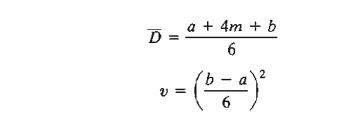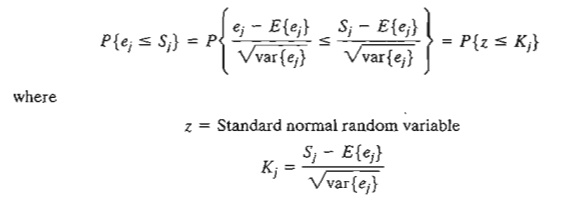Chapter: Operations Research: An Introduction : Network Models
CPM AND PERT: PERT Networks
PERT Networks
PERT
differs from CPM in that it bases the duration of an activity on three
estimates:
a.
Optimistic time, a, which occurs when execution goes extremely welL
b.
Most likely time, m, which occurs when execution is
done under nonnal conditions.
c.
Pessimistic time, b, which occurs when execution goes
extremely poorly.
The range
(a, b) encloses all possible estimates
of the duration of an activity. The estimate m lies somewhere in the range (a, b). Based on
the estimates, the average duration time, Bar(D), and variance, v, are approximated as:

CPM
calculations given in Sections 6.5.2 and 6.5.3 may be applied directly, with Bar(D)
replacing the single estimate D.
It is
possible now to estimate the probability that a node j in the
network will occur by a prespecified scheduled time, sj. Let ej
be the earliest occurrence time of node j. Because
the durations of the activities leading from the start node to node j are
random variables, ej also must be a
random variable. Assuming that all the activities in the network are
statistically independent, we can determine the mean, E{ej}, and vari-ance, var{ ej}, in the following manner. If there is only one path from the
start node to node j, then the mean is the sum of
expected durations,Bar( D), for all the activities along
this path and the variance is the sum of the variances, v, of the same activities. On the other hand, if more than one path
leads to node j, then it is necessary first to determine
the statistical distribution of the duration of the longest path. This problem
is rather difficult because it is equivalent to determining the distribution of
the maximum of two or more random variables. A simplifying assumption thus
calls for computing the mean and variance, E{ej}
and var{ej}, as those of the path to node j that has
the largest sum of expected activity
durations. If two or
more paths have the same mean, the one with the largest variance is selected
because it reflects the most uncertainty and, hence, leads to a more
conservative estimate of probabilities.
Once the
mean and variance of the path to node j, E{ ej} and var{ej}, have been computed, the probability
that node j will be realized by a preset time sj is calculated using the
following formula:

The
standard normal variable z has mean 0
and standard deviation 1 (see Section 12.4.4). Justification for the use of the
normal distribution is that ej is the
sum of independent random variables. According to the central limit theorem (see Section 12.4.4), ej is approximately normally distributed.
Example 6.5-6
Consider
the project of Example 6.5-2. To avoid repeating critical path calculations,
the values of a, m, and b in the table below are selected such
that Bar(Dij ) = Dij for all i and j in Example 6.5-2.

The mean Bar(Dij) and
variance vij for the different activities are given in the
following table. Note that for a dummy activity (a, m, b) = (0,0,0), hence its mean and
variance also equal zero.

The next
table gives the longest path from node 1 to the different nodes, together with
their associated mean and standard deviation.

Finally,
the following table computes the probability that each node is realized by time
sj
specified by the analyst.

PROBLEM
SET 6.5E
Consider Problem 2, Set 6.Sb. The estimates (a, m, b) are
listed below. Determine the probabilities that the different nodes of the
project will be realized without delay.

Related Topics